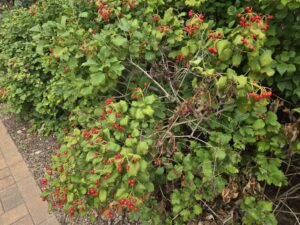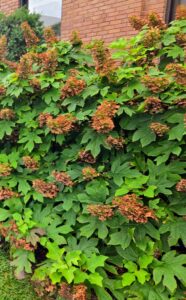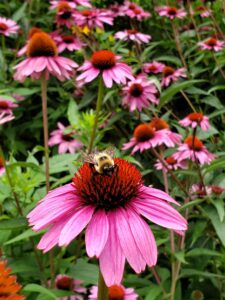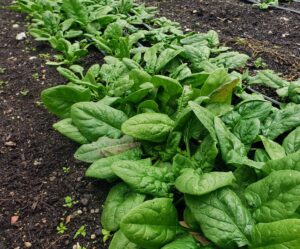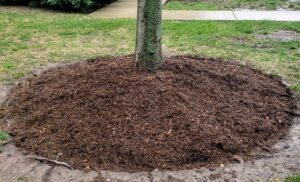Fall is quickly approaching, bringing cooler temperatures, refreshing rains, and fewer pests. It’s a perfect time to tackle garden tasks, from pruning perennials to planting vegetables.
Pruning
Fall is a good time to prune out dead, damaged, or diseased plant material (Fig. 1). You can also tidy up perennials that have finished blooming and make light shaping cuts on shrubs. Consider saving some stems when cutting back the spent blooms of herbaceous perennials. When left standing, these stems provide habitat for pollinators and food for wildlife while also adding winter interest to a garden that may otherwise remain empty for the cold months ahead (Fig.2).
- Figure 1. The highbush cranberry (Viburnum opulus) provides year-round interest with ornate flowers, bright berries, and vibrant fall foliage. These spring-blooming shrubs are best pruned after flowering, but damaged or diseased branches can be pruned out at any time.
- Figure 2. When left standing, the spent blooms of purple coneflower (Echinacea purpurea) provide habitat and food for wildlife while adding winter interest.
Do not prune spring-blooming shrubs such as lilacs, forsythia, or spicebush in the fall, otherwise you’ll cut off next year’s flower buds. The bigleaf and oakleaf hydrangea also produce blooms on old wood (Fig. 3). These are best pruned immediately after flowering. Always use sharp, clean tools and cut just above a bud or branch junction at a slight angle. For pruning best practices along with a comprehensive list of recommended pruning times for common woody perennials, refer to Pruning Ornamental Trees and Shrubs.
- Figure 3. The ‘Ruby Slippers’ oakleaf hydrangea (Hydrangea quercifolia) should be pruned after flowering to remove spent blooms, maintain shape, or reduce the overall size. However, as seen here, spent blooms may be left for continued interest.
Planting
Fall is prime time to plant hardy perennials, trees, and shrubs. The soil remains warm long after the air temperature drops, giving roots time to establish before the ground freezes. Aim to finish planting by mid-to-late October in most parts of Indiana. Consider natives such as purple coneflower (Fig. 4), serviceberry, or buttonbush for low-maintenance beauty. Visit the Indiana Native Plant Society’s Native Plant Finder to explore other native options for your landscape.
- Figure 4. Purple coneflower (Echinacea purpurea) has a long bloom period starting in June and extending into September or October. The vibrant blooms also provide food for a wide range of pollinators.
It’s also the season for planting bulbs for spring blooms and vegetables for a fall harvest. Tulips, daffodils, and crocus should be planted before the soil freezes to provide a burst of early spring color. You can also sow quick-growing cool-season vegetables like leaf lettuce, spinach, and radishes for a fall harvest (Fig. 5). Check out The Fall Vegetable Garden for a planting guide on cool-season vegetables.
- Figure 5. The cooler conditions in fall are ideal for cool-season crops like spinach, which prefer temperatures between 50°F and 60°F.
Prep for Winter Protection & Spring Success
Trees, shrubs, and perennials should continue to be irrigated deeply up until the ground freezes. Add a layer of mulch after the soil cools to insulate roots from harsh temperature swings. Be sure to keep mulch a few inches away from tree trunks or shrub stems to prevent rot or rodent damage (Fig. 6). Winterize Your Trees offers more tips on protecting your perennials from the often frigid and dry conditions of an Indiana winter.
- Figure 6. Adding a layer of mulch around trees and shrubs insulate the roots from harsh temperatures and help to retain moisture. However, avoid piling mulch against the trunk. Volcano mulching, as seen here, causes problems such as rot and provides shelter for rodents as they chew on the trunk.
Referenced resources
Pruning Ornamental Trees and Shrubs – Purdue Extension HO-4-W
https://www.extension.purdue.edu/extmedia/HO/HO-4-W.pdf
Indiana Native Plant Society’s – Native Plant Finder
https://finder.indiananativeplants.org/
The Fall Vegetable Garden – Purdue Extension HO-66-W
https://www.extension.purdue.edu/extmedia/HO/HO-66-W.pdf
Winterize Your Trees – Purdue Extension FNR-484-W
